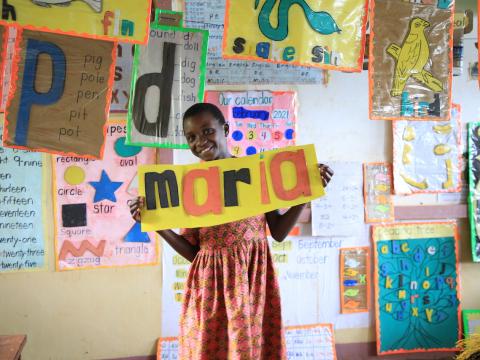Print-rich classrooms support early learning in Uganda

Kawami Primary School in Budde Kalamba, Butambala District in Central Uganda, is a beehive of activity. Primary Four pupils are busy cutting out letters of the alphabet in a print-rich classroom. In this class, pupils interact with different forms of print to foster reading skills.
Maria, 10, using a pair of scissors, cuts letters out of a soft spongy material. In another corner of the classroom, a group of boys and girls are sticking the cut letters on manilla cardboards using paper glue. Some are inscribing numbers on plastic bottles, as others are hanging embellished bottles on threads crisscrossing the classroom. In a short while, the whole classroom is lit with beautifully designed numbers, shapes and letters of different colours.

Print-rich classrooms make use of locally available materials like banana fibres, polythene bags, plastic bottles, bottle tops, wood, boxes, paper, and glue. World Vision provides rubbers, markers, charts and polythene paper for covering the finished learning materials from dust and for longer shelf life.
“I am happy that things that we considered as rubbish are now decorating our classes and helping us to learn. Before print-rich classrooms were introduced in our school, learning was boring. It was difficult to understand what the teachers were saying,” says Maria.
Lisa Nalwanga, Maria’s teacher, says print-rich classrooms, also known as ‘talking classrooms’ simplify study topics and complicated concepts. By using objects that children can easily identify with, Lisa says you make it simpler for the children to understand. “Like using infographics to break down complicated statistics or information, children in lower classes understand easier with touching and using colourful items. These classrooms are appropriate for all classes right from nursery to Primary Seven.”
Like other students, Maria is enjoying studying more than before. She says a lot has changed:
Even if the teacher is not in class, learning is continuous with these charts displayed all over. Everywhere you look, you are able to read, learn or remind yourself of something. So when teachers come, we share with them what we learnt in their absence. Learning is more fun, and my performance has really improved compared to the past years. I can now spell words using sounds.”
World Vision’s Programme Officer, Mary Nakiganda, shares that a few years back Butambala was among the worst-performing districts in the country in terms of education indicators. “Before, you would hardly get a school in Butambala with the first grade in Primary Leaving Examinations (final exams before transitioning to secondary school). Schools didn’t have teaching and learning materials as it is now. The classroom environment was not inspiring at all. Children couldn’t read and this affected their learning”, says Mary.
Working alongside families, communities and local district education partners in Budde-Kalamba, World Vision is helping children take an active role in their own learning with their families, in building lives free of need and full of promise. “We are working together with children, parents, teachers, supporters, partners and communities in collective efforts to enrich the lives of all involved”, notes Mary. “We are helping change the classroom ambience from an empty dull hall to a colourful live learning museum for children because we know the lasting impact of quality education the lives of children now and in generations to come.”
Now, in Budde-Kalamba, it is common to find parents involved and interested in the learning of their children; a thing that was almost unheard of before. “The print-rich classroom project has absorbed everyone. Parents are providing and creating beautiful materials for their children’s learning. The active participation of parents and caregivers is the biggest achievement of this initiative, and we are super excited”, says Mary.

Previously, Josephine Nabanooba, Maria’s mother, like most parents in her community, did not care much about her daughter's education. All she knew as her responsibility was to send her child to school. “Honestly, I wasn’t into the business of looking for and creating learning materials. I expected my child to be well facilitated at school. But now I now know better. A parent’s participation in their child’s learning is critical”, says Josephine, now a lead parent mobilising other parents to change the classroom environment in their communities. “The only investment cost is time, the time to collect banana fibres, boxes and bottles and then creating objects.”
Josephine has gone a step further and made the same materials to help Maria study when at home. With learning materials available at school and at home, Maria is a better learner. “I’m able to learn from everywhere I look, whether at home or school”, she says.
Her teacher, Lisa, can’t agree anymore. She says, “Maria is a reading champion. She exudes the confidence of a champion when reading. She has really improved, thanks to World Vision for making this possible.”
Since 2019, World Vision has impacted 3,500 children (2,053 girls and 1,447 boys) in Budde-Kalamba Area Programme in Butambala District through print-rich classrooms. In Maria’s school alone, 177 children (92 boys and 85 girls) have been reached so far.
By Emmanuel A. Okello, Communications Officer – World Vision Uganda